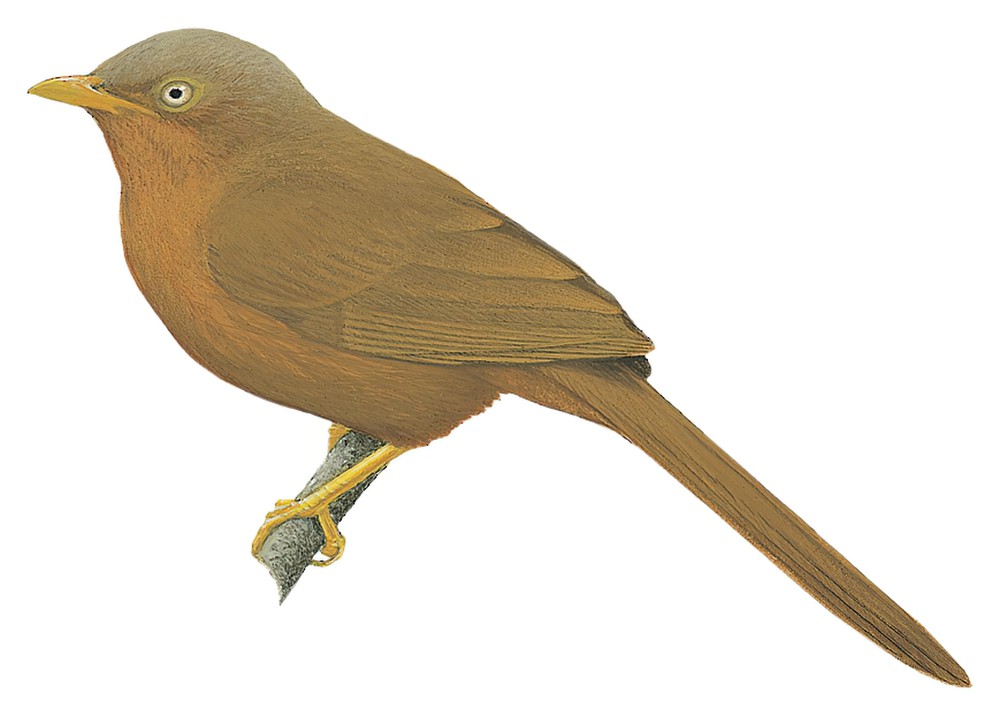Orange-billed Babbler / Turdoides rufescens

Orange-billed Babbler
SCI Name:
Protonym: M[alacocercus]. rufescens J.Asiat.Soc.Bengal 16 p.453
Taxonomy: Passeriformes / Leiothrichidae / Turdoides
Taxonomy Code: orbbab1
Type Locality: Ceylon.
Author: Blyth
Publish Year: 1847
IUCN Status: Near Threatened
DEFINITIONS
TURDOIDES
(Leiothrichidae; Ϯ White-headed Babbler T. leucocephala) Genus Turdus Linnaeus, 1758, thrush; Gr. -οιδης -oidēs resembling; "Turdoides leucocephala, (Mus. Francof.) Weißköpfiger Droßling. ... Die Droßlinge (Turdoides) bilden eine von den Droßeln (Turdus) wohl zu unterscheidende Familie, die eine Menge von Arten zählt, von denen Rüppel bereits vier aus dem nördlichen Afrika eingesendet hat. Wir werden die Abbildungen und Beschreibungen von dreyen derselben in dem Atlas liefern. Auch erwarten wir duie Bekanntmachung anderer in Indien entdeckten Arten der Gattung Turdoides von Herrn Temminck, der solche zuerst aufgestellt hat." (Cretzschmar 1827); "Turdoides Cretzschmar, 1827, in Rüppell's Atlas, Vög., hft. 4, p. 6, pl. 4. Type, by monotypy, Turdoides leucocephalus Cretzschmar." (Deignan in Peters 1964, X, 331).
Var. Tordoides.
Synon. Aethocichla, Aipunemia, Crateropus, Cratopus, Ischyropodus, Layardia, Malacocircus, Malcolmia, Pengia.
turdoides
L. turdus thrush; Gr. -οιδης -oidēs resembling.
● “Both Seebohm and Saunders have used Meyer’s name Sylvia turdoides, 1815, for the Great Reed-Warbler, because, according to the first named, Linnaeus in placing the species under the genus Turdus made the definition quite misleading. Turdus arundinaceus of Linnaeus was, however, founded on Klein’s Turdus musicus palustris, which undoubtedly refers to the Great Reed-Warbler, and there can be no objection to the name, which is the oldest and has always been more or less in use” (BOU 1915) (syn. Acrocephalus arundinaceus).
● “Altogether of a much Thrush-like appearance” (Hartert 1896) (Cataponera).
● "14. COLLURICINCLE GRIVELÉ. — COLLURICINCLA TURDOIDES. ... Ce Colluricincle est originaire de Raffles-Bay. Il appartient à la section des espèces de ce genre qui est caractérisée par un bec plus large et moins comprimée. Ses couleurs et sa petite taille le rapprochent du Colluricincla brunnea Gould; il s'en isole par la coloration à peu près uniforme de la région thoraco-abdominale." (Pucheran 1853) (syn. Colluricincla parvula).
rufescens
L. rufescens, rufescentis reddish < rufescere to become reddish < rufus red.
● ex “Aigrette rousse de la Louisiane” of d’Aubenton 1765-1781, pl. 902, “Aigrette rousse” of de Buffon 1770-1783, and “Reddish Egret” of Pennant 1785, and Latham 1785 (Egretta).
● ex “Gobe-mouche roux de Cayenne” (= ♀) of d’Aubenton 1765-1781, pl. 453, fig. 1, and de Buffon 1770-1783, and “Rufous Fly-catcher” of Latham 1783 (syn. Pachyramphus rufus).
● ex “Red-backed Pelican” of Latham 1785 (Pelecanus).
● ex Tringa fulicaria Linnaeus, 1758, and “Phalarope roussâtre” of Brisson 1760 (syn. Phalaropus fulicarius).
● ex “Ynambú guazú” of de Azara 1802-1805, no. 326 (Rhynchotus).
● ex “Crombec” or “Figuier à Bec Courbi” of Levaillant 1803, pl. 135 (Sylvietta).
UPPERCASE: current genus
Uppercase first letter: generic synonym
● and ● See: generic homonyms
lowercase: species and subspecies
●: early names, variants, mispellings
‡: extinct
†: type species
Gr.: ancient Greek
L.: Latin
<: derived from
syn: synonym of
/: separates historical and modern geographic names
ex: based on
TL: type locality
OD: original diagnosis (genus) or original description (species)












